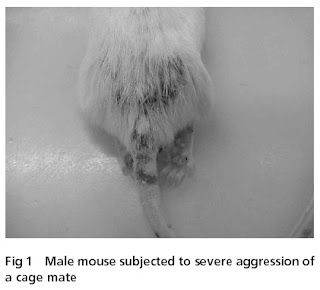
I have said on a number of occasions that the UW-Madison vivisectors act
as if they see themselves above the law. Just how stupid does someone have to be, after seeing all the university has done over the years, to still qualify the observation that the university feels it is above the law with "as if"? Pretty dumb, I would say. Mea culpa.
I won't have to say that any more. The university has announced to all who would listen that they are absolutely above the law. They have stated clearly and succinctly in the University System Omnibus Motion:
Liability Protections for Scientific Researchers: Specify that current law provisions prohibiting crimes against animals would not apply to persons engaged in bona fide scientific research at an educational or research institution or persons who are authorized or otherwise regulated under federal law to utilize animals for these purposes.
They slipped this provision into the pending state budget bill because they know with absolute certainty that the provision could not stand alone or weather informed debate. This is a dishonest ploy to exempt themselves from Wisconsin's "Crimes Against Animals" statutes,
Chapter 951 of the state code.
If you check it out, you'll see that there are already two exemptions given to those experimenting on animals.
951.02 Mistreating animals. No person may treat any animal, whether belonging to the person or another, in a cruel manner. This section does not prohibit bona fide experiments carried on for scientific research or normal and accepted veterinary practices.
and then again,
951.06 Use of poisonous and controlled substances. No person may expose any domestic animal owned by another to any known poisonous substance, any controlled substance included in schedule I, II, III, IV or V of ch. 961, or any controlled substance analog of a controlled substance included in schedule I or II of ch. 961, whether mixed with meat or other food or not, so that the substance is liable to be eaten by the animal and for the purpose of harming the animal. This section shall not apply to poison used on one's own premises and designed for the purpose of rodent or pest extermination nor to the use of a controlled substance in bona fide experiments carried on for scientific research or in accepted veterinary practices.
There is also an exemption in 951.10 for people who wish to sell baby rabbits, chicks and other fowl to vivisectors.
If the university gets its way, and I suspect they will, they will be formally outside the law. Vivisectors will no longer be barred by statute from:
951.025 Killing an animal by means of decompression.
951.03 Dognapping and catnapping.
951.04 Leading an animal from a motor vehicle.
951.05 Transporting any animal in or upon any vehicle in a cruel manner.
951.07 Using certain devices: (a bristle bur, tack bur or like device; or a poling device used to train a horse to jump which is charged with electricity or to which have been affixed nails, tacks or other sharp points.)
951.08 Instigating fights between animals.
951.09 Shooting at caged or staked animals.
951.095 Harassing police and fire animals.
951.097 Harassing service dogs.
951.11 Selling artificially colored animals.
951.13 Not providing proper food and drink to confined animals.
951.14 Not providing proper shelter.
951.15 Abandoning animals.
The university's demand that they be exempt from Chapter 951 is breathtaking, stunning, telling. I worry about them though, being so high above the ground, they must all be experiencing nosebleeds, headache, and extreme lightheadedness, which in itself may explain their absurd self-image.
rarefied: Belonging to or reserved for a small select group; exalted in nature or character; exclusive.
Want to do something about this grotesque attack? If you live in Wisconsin or visit Wisconsin, or have simply only heard of Wisconsin, call the state legislators and tell them that no one should be exempted from laws against cruelty. Ask them to remove Item 27 from the University of Wisconsin System Omnibus Motion.
You can look up their phone numbers
here.



